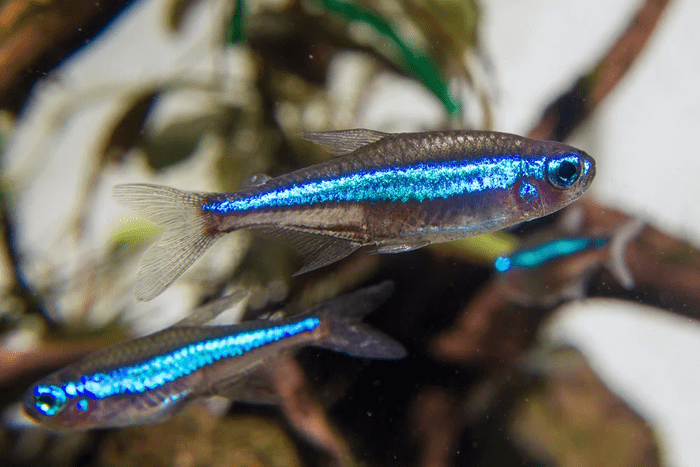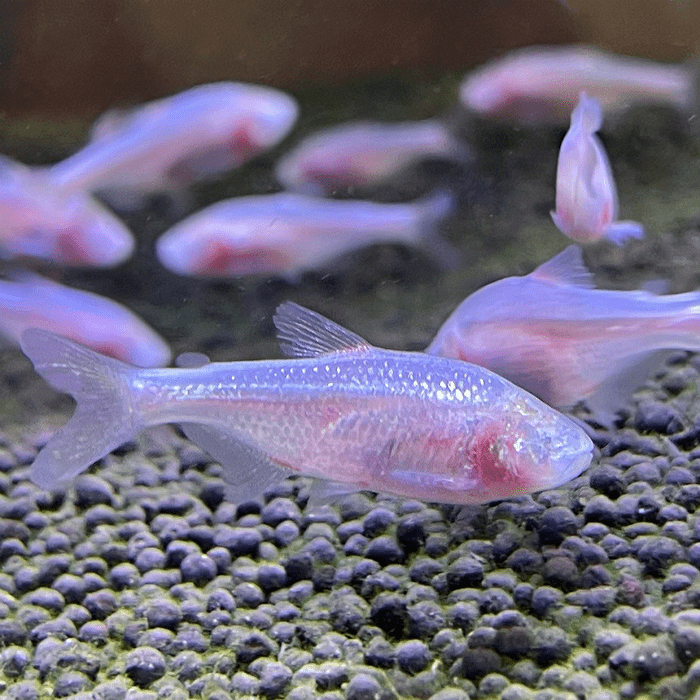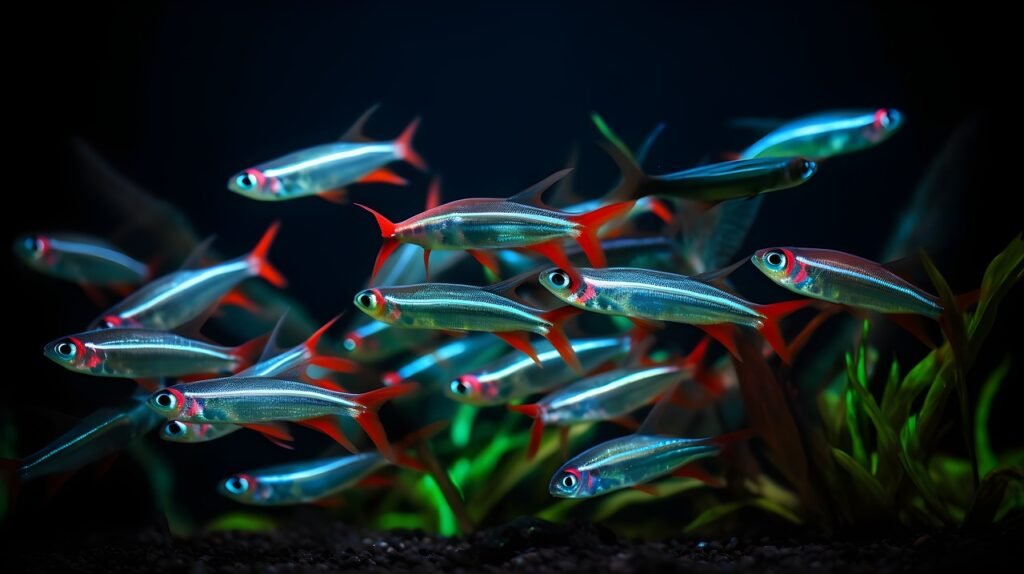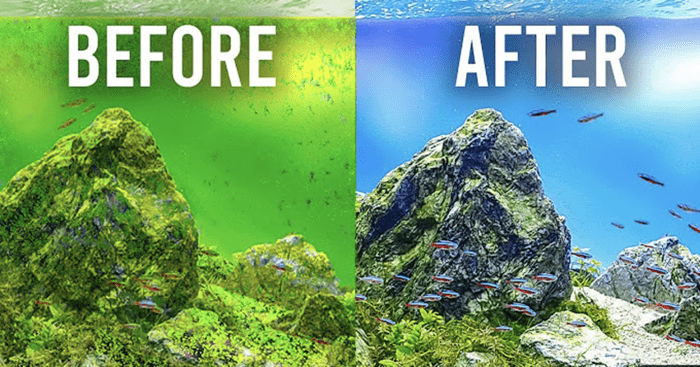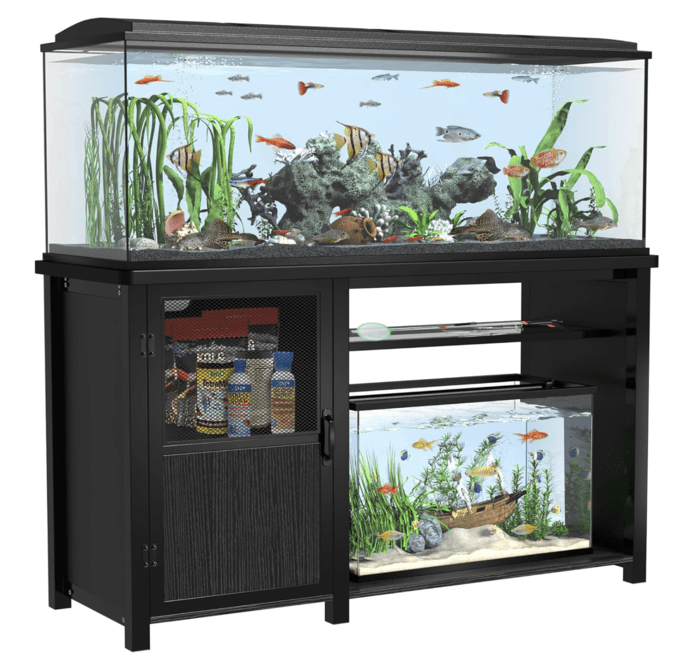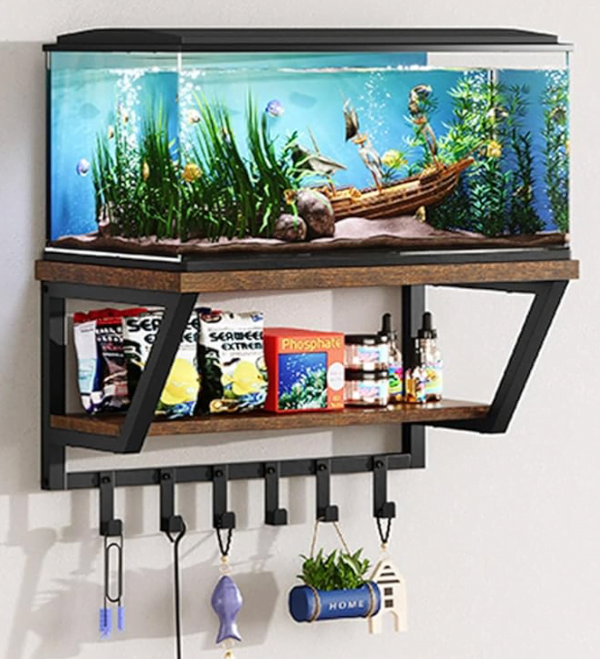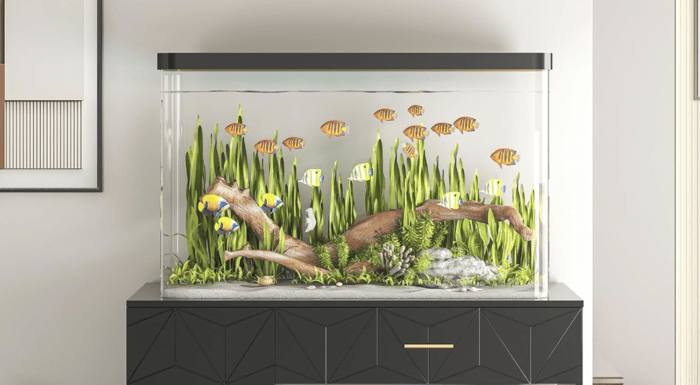Best Food For Tetra: A Comprehensive Guide

Finding the right food for your tetra can be a challenge. One important fact to know is that tetras are omnivorous, meaning they eat both plants and meat. This article will guide you through the best nutritional choices for your fish, ensuring they lead a happy and healthy life.
Let’s get started!
Key Takeaways
- Tetras enjoy a varied diet including plants and small water creatures, making them omnivorous. Feed them flake foods, freeze-dried bloodworms, brine shrimp, and vegetable matter to meet their dietary needs.
- Maintain a feeding schedule of twice daily for neon tetras following the three-minute rule to avoid overfeeding and tank pollution. This helps keep tetras healthy and vibrant without harming their environment.
- Offering a mix of dry food options like TetraColor Tropical Flakes or Hikari Micro Pellets alongside frozen or live treats such as blackworms enhances coloration and supports the well-being of tetra fish in home aquariums.
- Specific species of Tetra fish such as Neon Tetra, Cardinal Tetra, Ember Tetra, Rummy Nose Tetra, Congo Tetra, Black Skirt Tetra, and Lemon Tetra thrive on tailored diets that reflect their unique preferences and natural habitats for optimal health.
- Keeping your aquarium clean with good filtration systems while providing a balanced diet ensures the longevity and vibrancy of your tetras. Always ensure there’s enough space by following approximately one gallon of water per fish rule to support their wellbeing.
What is a Tetra Fish?
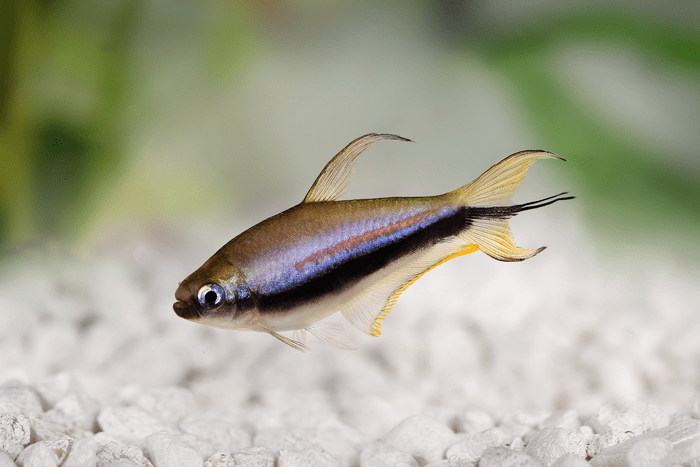
Tetra fish sparkle in home aquariums with their vibrant colors and lively behavior. Originating from tropical regions, these small but dynamic swimmers light up both low-tech setups and community tanks, sharing spaces peacefully with guppies and other friendly species.
Tetra Origin
Tetras hail from various parts of South America and Africa, thriving in diverse freshwater environments. These small, colorful fish have adapted to life in everything from clear streams to the murky waters of the Amazon Basin.
Their origin in these biodiverse regions has equipped them with a unique set of survival skills, including a varied diet that allows them to thrive in many conditions.
This adaptability makes tetras popular among aquarists worldwide. They not only bring vibrant colors to community tanks but also serve as a living link to the rich aquatic habitats of their native lands.
Understanding where tetras come from helps fish keepers create better environments for them, replicating aspects of their natural habitat such as water quality and food sources for optimal health and longevity.
Tetra Characteristics
Tetra fish boast vivid colors and a peaceful nature, making them ideal for community aquariums. They thrive in slightly acidic water conditions, with pH levels between 4 and 7.5 being perfect for their health and breeding.
These small but lively creatures require a well-balanced diet to maintain their bright hues and energy. Offering them a mix of flakes, freeze-dried foods like bloodworms, shrimp pellets, brine crustaceans, frozen food items, plant materials, and algae meets their nutritional needs effectively.
To keep tetras happy and healthy, it’s crucial to mimic their natural habitat as closely as possible within an aquarium setting. This includes providing dimly lit areas where they can hide since they are known for being shy and easily frightened.
Keeping them in groups helps minimize stress because these fish prefer the company of their own kind; roughly one gallon of water per fish is a good rule of thumb to ensure enough space for everyone.
Setting up the right environment directly impacts their well-being which influences how much they eat.
A balanced diet ensures vibrant colors and vitality in Tetra fish.
Understanding Tetras’ Diet comes next.
Understanding Tetras Diet

Tetras show a love for variety in their food, much like humans enjoy different meals. They thrive on both plant and small water creature-based diets, revealing their omnivorous nature.
The Omnivorous Nature of Tetras
Tetras enjoy a varied diet, showing their omnivorous nature. They thrive on both plant and animal foods, making them adaptable to different feeding options in home aquariums. This includes flake food designed for tropical fish, small crustaceans like brine shrimp, and insect larvae such as bloodworms.
Offering this mix mimics their natural eating habits and supports their health.
They also benefit from occasional treats of vegetable matter or high-quality pellets that cater to omnivorous fishes. Feeding tetras the right blend of nutrients ensures they display vibrant colors and maintain an active lifestyle in your tank.
Use these tips to keep your tetra school healthy and lively by providing a balanced diet that reflects their diverse palate.
What Tetra Eat In The Wild
Moving from understanding their omnivorous nature, it’s crucial to explore the natural diet of tetra fish in their wild habitat. Tetras thrive on a varied diet that includes plant materials, small crustaceans, and microorganisms found in water.
These elements provide them with the necessary nutrients for growth and health.
In their native South American rivers, neon tetras specifically feed on algae and tiny water-dwelling creatures. This environment offers slightly acidic water that suits their needs perfectly.
The availability of such food sources plays a significant role in maintaining the vibrant colors and energy levels of these fish in the wild.
How Often To Feed Tetra
Feeding your tetra fish the right way plays a big role in keeping them healthy and vibrant. For neon tetras, experts suggest feeding them twice a day, sticking to the 3-minute rule for each session.
This means you give them as much food as they can eat in three minutes, no more. It’s crucial not to overfeed to avoid polluting their tank.
Fish keepers often wonder about the best schedule for feeding their aquatic friends. Consistency is key. Set fixed times each day for feeding to help regulate their digestion and reduce stress levels in your fish.
Following this routine ensures your tetra receive proper nutrition without risking overfeeding or polluting their environment.
A well-fed fish is a happy fish.
How Much To Feed Tetra
Determining the right amount to feed your tetra is crucial for their health. Follow the three-minute rule during each feeding session. This means you give them as much food as they can eat in three minutes, no more.
Overfeeding leads to water quality issues and health problems for the fish. For neon tetras, twice a day feeding fits their needs well.
Use a variety of foods to ensure your tetras get all necessary vitamins and minerals. Mix it up between best dry food options like flakes or pellets, frozen choices such as freeze-dried bloodworms, and live treats including blackworms or daphnia.
A balanced diet not only keeps them healthy but also vibrant and active in your aquarium.
Recommended Dry Food Options for Tetras
Exploring the best dried meal choices for Tetras opens up a world of vibrant health and energy for your fish. With options like TetraColor Tropical Flakes, REAL OCEANIC EGGS, and Hikari Tiny Granules, you’ll find the perfect fit to keep your aquatic friends thriving.
Dive into this section to discover how these foods can transform your aquarium’s feeding routine.
TetraColor Tropical Flakes
TetraColor Tropical Flakes stand out as a top choice for feeding tetras in your aquarium. This fish food promotes vibrant colors in your pets, thanks to its blend of essential nutrients.
The flakes are easy for tetras to eat, making them an excellent option for daily meals. They contain ingredients that boost the health and coloration of your fish, ensuring they look their best.
Feeding TetraColor Tropical Flakes supports overall growth and vitality in tetras. These flakes dissolve slowly in water, preventing waste and keeping the tank clean. They’re packed with biotin and other vitamins to strengthen fish against stress and diseases.
For aquarists aiming to enhance the beauty of their tetra collection while supporting healthy living conditions, this food is a brilliant pick.
R.O.E.™ – REAL OCEANIC EGGS
R.O.E.™ – REAL OCEANIC EGGS pack a nutritious punch for your tetra fish, being a dense source of marine-derived omega fatty acids. These unique feed options provide essential nutrients that mimic the natural diet tetras would enjoy in the wild.
Offering R.O.E. can support the overall health and vibrant colors of your fish, making it an ideal choice for those seeking top nutrition without navigating complex feeding schedules.
Feed your tetras with R.O.E. to bring out their best colors and ensure optimal health.
Experts recommend integrating R.O.E. into your aquarium feeding regimen as part of a balanced diet. This approach helps meet the dietary needs of tetras, allowing them to thrive in home aquariums just as they would in nature’s waters.
Use this food option to give your fish what they naturally crave while enjoying the convenience of easy-to-manage feeds that keep water clean and clear.
Hikari Micro Pellets
Hikari Micro Pellets stand out as the best dry food for tetra fish due to their unique formula. These tiny pellets pack a nutritious punch, providing tetras with a balanced diet that supports overall health.
They float and then slowly sink, catering to the feeding habits of mid-water and bottom-feeding tetras. This feature ensures every fish gets its share in a community tank setting.
The compact size of Hikari Micro Pellets makes them easy for all sizes of tetra fish to eat, from the neonite tetra to larger species like the Congo swimming creature. With ingredients aimed at enhancing color and vitality, these pellets are an ideal choice for keeping your aquarium dwellers vibrant and active.
Moving on, let’s explore the benefits of frozen and freeze-dried foods for your aquatic friends.
Frozen and Freeze-Dried Food for Tetra
Tetras thrive on a varied diet, including frozen and freeze-dried options. These choices provide essential nutrients that help keep your fish healthy and vibrant.
Freeze-dried bloodworms
Freeze-dried bloodworms serve as a top choice for the diet of tetra fish. These dried creatures pack a nutritious punch, catering to the natural eating habits of tetras in their wild surroundings.
Without adding any unwanted chemicals to your aquarium, this food promotes vibrant colors and energy in your fish.
Feeding freeze-dried bloodworms is like bringing the richness of their natural habitat into your home aquarium.
These offerings are easy for fish keepers to store and use, making them an essential part of feeding routines. They dissolve quickly in water, ensuring that tetras can easily consume them without stress.
This quality makes freeze-dried bloodworms not only convenient but also a practical option for maintaining happy and healthy fish.
Brine Shrimp
Brine shrimp make an excellent choice for feeding neon tetras and other tetra species. These small crustaceans pack a nutritious punch, offering high-quality proteins that support fish health.
They are ideal for preventing disease in your aquarium by supplying essential vitamins and minerals necessary for a balanced diet. Offering brine shrimp to your tetras can introduce variety into their feeding routine, ensuring they receive all the nutrients they need to thrive.
Fish keepers often choose frozen or freeze-dried brine shrimp due to their convenience and long shelf life. These forms retain most of the nutritional value found in live brine shrimp, making them a practical option without the hassle of managing live food stocks.
By incorporating brine shrimp into your feeding schedule, you provide your tetras with a food source that mirrors what they would consume in the wild, promoting natural behaviors and contributing to their overall well-being.
Dried Daphnia
Dried Daphnia offers nutritious benefits for Tetras, making it one of the best freeze-dried food choices. These tiny crustaceans are packed with fiber and protein, vital for your Tetra’s growth and health.
They float on the water surface, encouraging natural hunting behaviors in fish.
Feeding Tetras dried Daphnia also helps keep their system clean because of its high fiber content. This option is perfect for fish keepers using automated feeders during travel since it stores well without the risk of carrying diseases or parasites like some frozen foods do.
Next, discover why Blackworms stand out as a top live food choice for Tetras.
Best Live Food For Tetra
Choosing live food for tetra brings your fish closer to their natural diet. Fish like neon and Congo tetra thrive on small aquatic invertebrates such as blackworms and water fleas, enhancing their health and color.
Blackworms
Blackworms serve as a fantastic live food choice for Tetra fish, offering rich nutrients and stimulating their natural hunting instincts. These slender worms encourage your tetras to engage in active feeding behavior similar to their wild habits.
Offering blackworms not only supports the dietary needs of tetras but also contributes to their overall well-being by keeping them lively and healthy.
Feeding your Tetra fish with blackworms mimics their natural diet, promoting vibrant health and activity levels.
Daphnia
Daphnia, often known as water fleas, serve as excellent live food for neon tetras. These tiny crustaceans pack a nutritional punch that can help meet the dietary needs of your fish.
Feeding daphnia to neon tetras not only contributes to their nutrition but also stimulates natural hunting behaviors, making mealtime more engaging for them.
Introducing daphnia into the diet of your neon tetra is simple and beneficial. These critters support healthy growth and vibrant coloration in fish. Neon tetra keepers should consider adding daphnia to their aquarium inhabitants’ diet for an improved feeding regimen that mirrors wild eating patterns closely.
This choice aids in creating a balanced and varied menu for your pet fish, enhancing their overall well-being without introducing unnecessary complexities into tank maintenance routines.
Best Food for Tetra Species
Each Tetra species thrives on a unique diet that suits its specific needs. For Neon Tetras, Cardinal Tetras, and other types, choosing the right food ensures their health and longevity.
Neon Tetra
Neon Tetras thrive on a varied diet to stay healthy and vibrant. These small, brightly colored fish love munching on flakes and freeze-dried bloodworms. Offering them shrimp pellets and brine shrimp keeps their menu interesting.
Don’t forget about frozen treats; they’re essential for a balanced diet. Plant matter and algae also make great snacks for these little swimmers. Keeping their feeding schedule regular with two meals a day ensures they get enough nutrients without overdoing it.
For the best results in your aquarium, follow the three-minute rule at each feeding time. This method helps prevent overfeeding while making sure every Neon Tetra gets its share of the food.
Since they come from freshwater habitats in South America, mimicking their natural diet as closely as possible will keep them feeling right at home in your tank. With proper care and nutrition, these community-friendly fish can light up any aquarium with their neon glow for years to come.
Cardinal Tetra
Cardinal Tetras thrive on a varied diet, much like their Neon Tetra cousins. Feed them flakes, freeze-dried bloodworms, and shrimp pellets to keep them healthy. These radiant fish also enjoy plant-based nutrients and love noshing on algae in their tanks.
Including brine shrimp and frozen fare as part of their meals keeps them vibrant and full of life.
Keeping Cardinal Tetras in groups boosts their well-being, making it essential to consider when planning meal portions. A balanced diet ensures they stay resilient against diseases common in their species such as Neon Tetra Disease and Hexamita.
With stable water conditions between 20-28 degrees Celsius and a slightly acidic pH level of 4-7.5, these South American natives will showcase their serene beauty effortlessly in your aquarium setup.
Ember Tetra
Moving from the care needs of Cardinal Tetra, Ember Tetras also require attention to their diet for optimal health. These small, fiery-colored fish thrive on a variety of foods that cater to their omnivorous nature.
Best food choices for Ember Tetra include fine flakes, micro pellets, and freeze-dried bloodworms which provide the nutrition they need without overburdening their tiny mouths. It’s important to select foods specifically designed for small species like them to ensure they can easily consume and digest it.
For those looking to enhance coloration while supporting overall well-being, incorporating small live or frozen options such as brine shrimp or daphnia can make a significant difference.
These additions not only satisfy their natural hunting instincts but also supply essential nutrients absent in dry formats. Keep meal sizes modest and consistent with Ember Tetras’ active yet minute appetite to avoid waste accumulation in the tank environment that could harm water quality over time.
Rummy Nose Tetra
Rummy Nose Tetras thrive in slightly acidic water and enjoy a varied diet much like their cousins, the neon tetras. To keep them healthy, offer a mix of high-quality flake foods, small frozen delights such as brine shrimp, and vegetable bits to mirror their natural intake.
These South American natives do best when their meals include freeze-dried bloodworms and tiny shrimp pellets too. Ensuring they have access to both animal-based and plant-based nutrients will support their vibrant colors and active behavior.
For optimal care, group these striking fish in schools of at least ten to see them truly shine in your aquarium setup. Feeding them twice a day with just enough food that they can consume within three minutes prevents overfeeding and maintains the tank’s cleanliness.
Given Rummy Nose Tetras’ need for good filtration to thrive, align your feeding practices with maintaining top-notch water quality by not allowing leftover food to decay in the tank.
Congo Tetra
Congo Tetras thrive on a varied diet, mirroring their natural eating habits. These radiant fish, native to African waters, favor an omnivorous menu that combines plant and animal matter.
Opt for high-quality flake food or small pellets as the base of their diet. To mimic their natural feeding environment and ensure they display their brightest colors, include frozen or freeze-dried foods like bloodworms and brine shrimp.
Feeding Congo Tetras correctly involves not just choosing the right types of food but also considering how much and how often they eat. They do well with small amounts fed two to three times daily rather than one large feeding.
This approach prevents overfeeding and keeps their habitat cleaner by reducing uneaten food debris at the bottom of the tank—maintaining a beautiful view of these shimmering swimmers in your aquarium.
Black Skirt Tetra
Black Skirt Tetras thrive in slightly acidic environments, favoring a pH level between 6.5 and 7.5 for their home. These South American natives live best when the water quality is high, demanding good filtration systems to stay healthy.
To feed these vibrant swimmers properly, one should aim for a mixture of foods that mimic their natural diet. This includes selecting the best food choices which can range from small crustaceans to specialized flake or pellet foods designed for tetra species.
For Black Skirt Tetras, variety is key in their diet to ensure they receive all necessary nutrients for a long life span of up to seven years in aquariums. Incorporating freeze-dried bloodworms or brine shrimp offers them the animal protein they would find hunting in wild waters while algae-based flakes provide essential vitamins and minerals.
Keepers must present these meals in moderation twice daily to prevent overfeeding and maintain optimum tank health alongside other fish with similar peaceful temperaments.
Lemon Tetra
Lemon Tetra thrives on a varied diet that includes both dry and live foods. For the best outcomes, introduce flake food specifically designed for tropical fish. These flakes are rich in vital nutrients that support their health and vibrant color.
Mixing in frozen or live foods like bloodworms or brine shrimp a few times a week makes their diet more thrilling and mirrors what they eat in nature. This blend not only keeps them healthy but also encourages lively behavior.
Feeding Lemon Tetra correctly requires moderation to avoid overfeeding. Aim for small amounts that they can consume within three minutes, twice daily. Observing how quickly they finish their meal helps determine the perfect portion size, ensuring all get a chance to eat without polluting the tank water with leftovers.
By covering these nutritional bases, fish keepers can enjoy watching their Lemon Tetras flourish in both vibrancy and activity within the aquarium setting.
Larger Tetra
For larger tetra species, TDO CHROMA BOOST™ comes highly recommended. This food is available in various sizes to match the size of your fish. It’s also top-coated with Haematococcus pluvialis for that added health benefit.
These features make it an ideal choice to meet the nutritional needs of bigger tetras in your aquarium.
Offering R.O.E.™ – REAL OCEANIC EGGS can be another great way to feed larger tetras. These marine-derived eggs are packed with omega fatty acids critical for their growth and health.
This kind of diet mirrors what these fish would naturally consume in wild waters, supporting their overall well-being and vibrant colors.
Conclusion
Feeding tetras the right food keeps them healthy and vibrant. This guide shared top meal options like flake foods, freeze-dried treats, and live snacks to cater to their needs. Choose from products like TetraColor Tropical Flakes or natural choices such as daphnia for a balanced diet.
Keeping your tank buddies happy involves variety and knowing how much and how often to feed them. With these tips, your fish will thrive in their aquatic home.
FAQs
1. What is the best food for tetra fish?
The best food for tetra fish includes a mix of high-quality flakes, freeze-dried foods, and frozen options that cater to their dietary needs. For specific types like neon tetras or Congo tetras, tailored diets ensure optimal health.
2. How often should I feed my tetras?
Tetras thrive when fed small amounts two to three times a day. This mimics their natural feeding habits and helps prevent overfeeding which can harm water quality in your tank.
3. Can I feed shrimp to my tetra fish?
Yes, many tetra species enjoy eating shrimp as part of their diet. Shrimp provides valuable nutrients and variety, making it an excellent choice for supplementing their regular meals.
4. What are some feeding tips while on vacation?
To feed your tetra fish while on vacation, consider using an automatic feeder that dispenses food at set times or pre-measured vacation food blocks that slowly release food into the tank.
5. How long can tetras go without being fed?
Tetras can generally go without food for up to a week without adverse effects due to their ability to metabolize stored energy efficiently. However, it’s not recommended to regularly make them fast for this long as it could stress the fish.
Share Your Tetra Experiences
Do you have any stories or tips about your Tetra tank? Share them in the comments below!
Help Others Discover This Guide
Navigate the Tetra in your tank with confidence. This guide is your pathway to creating a vibrant and healthy aquatic showcase. Enjoy the dazzling colors and lively nature of these unique fish!

